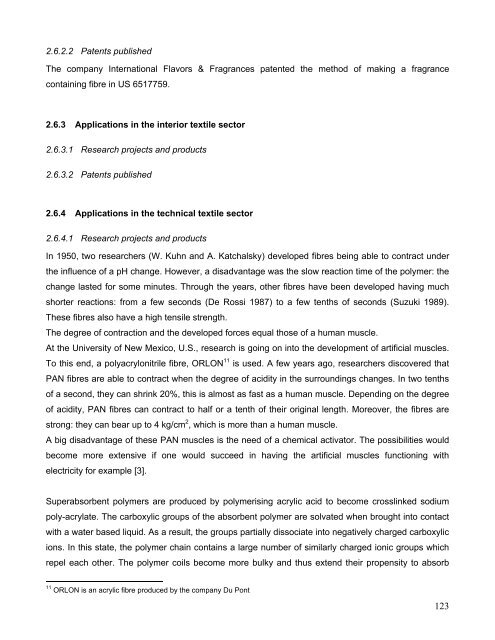Clevertex - Grado Zero Espace Srl
Clevertex - Grado Zero Espace Srl
Clevertex - Grado Zero Espace Srl
Create successful ePaper yourself
Turn your PDF publications into a flip-book with our unique Google optimized e-Paper software.
2.6.2.2 Patents published<br />
The company International Flavors & Fragrances patented the method of making a fragrance<br />
containing fibre in US 6517759.<br />
2.6.3 Applications in the interior textile sector<br />
2.6.3.1 Research projects and products<br />
2.6.3.2 Patents published<br />
2.6.4 Applications in the technical textile sector<br />
2.6.4.1 Research projects and products<br />
In 1950, two researchers (W. Kuhn and A. Katchalsky) developed fibres being able to contract under<br />
the influence of a pH change. However, a disadvantage was the slow reaction time of the polymer: the<br />
change lasted for some minutes. Through the years, other fibres have been developed having much<br />
shorter reactions: from a few seconds (De Rossi 1987) to a few tenths of seconds (Suzuki 1989).<br />
These fibres also have a high tensile strength.<br />
The degree of contraction and the developed forces equal those of a human muscle.<br />
At the University of New Mexico, U.S., research is going on into the development of artificial muscles.<br />
To this end, a polyacrylonitrile fibre, ORLON 11 is used. A few years ago, researchers discovered that<br />
PAN fibres are able to contract when the degree of acidity in the surroundings changes. In two tenths<br />
of a second, they can shrink 20%, this is almost as fast as a human muscle. Depending on the degree<br />
of acidity, PAN fibres can contract to half or a tenth of their original length. Moreover, the fibres are<br />
strong: they can bear up to 4 kg/cm 2 , which is more than a human muscle.<br />
A big disadvantage of these PAN muscles is the need of a chemical activator. The possibilities would<br />
become more extensive if one would succeed in having the artificial muscles functioning with<br />
electricity for example [3].<br />
Superabsorbent polymers are produced by polymerising acrylic acid to become crosslinked sodium<br />
poly-acrylate. The carboxylic groups of the absorbent polymer are solvated when brought into contact<br />
with a water based liquid. As a result, the groups partially dissociate into negatively charged carboxylic<br />
ions. In this state, the polymer chain contains a large number of similarly charged ionic groups which<br />
repel each other. The polymer coils become more bulky and thus extend their propensity to absorb<br />
11 ORLON is an acrylic fibre produced by the company Du Pont<br />
123

















